18 January 2021
We will continue our journey through the monuments of Almaty in a place popularly known as”Mother-in-law’s Language”.
This is the intersection of Abay Avenue and Baizakov Street. Abay Avenue is bifurcated here, resembling a snake’s tongue, for which this place received such an interesting name. The Mukhtar Auezov Theater is located nearby.
Interesting fact. In his square in 1967, a bust of the playwright Mukhtar Auezov was installed. The sculptor is Tulegen Dosmagambetov. Mukhtar Auezov’s two-volume novel “The Way of Abai ” was included in the”Library of World Literature”. The film based on his story “Fierce” was nominated by the USSR for the Academy Award.
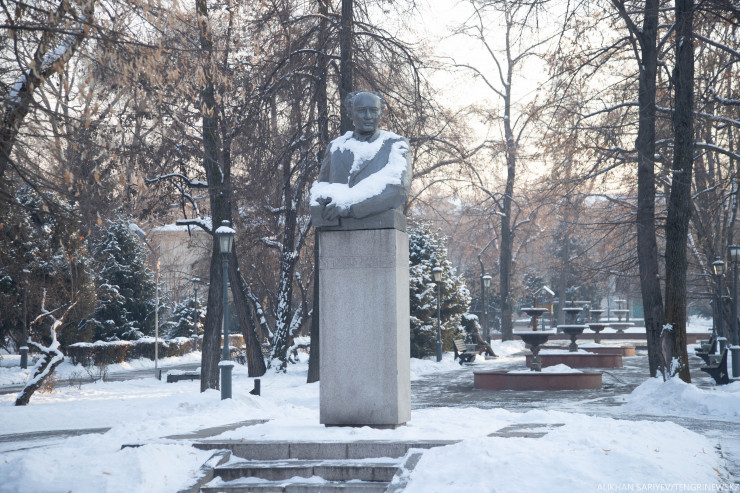
Фото©Алихан Сариев
Mukhtar Auezov is the author of the play “Enlik-Kebek”, dramas” Kara-Koz”,”Baibishe-tokal”. He wrote more than 20 plays, including: “Ayman-Sholpan “(1934), “Abai” (staged in 1940, together with L. S. Sobolev), ” Karakoz “(1926),” Kara Kipchak Koblandy “(1943-1944),” Zarnitsa “(1934),” On the Border “(1937),” In the hour of trials “(1942), the script of the film” Songs of Abai ” (1945) and others.
You can also find a bust of Abylai Khan nearby. It is located on the territory of the Kazakh University of International Relations and World Languages, which is named after the Kazakh Khan. By the way, another monument to a historical figure is located at the Almaty-2 railway station.
Then we suggest just walk along the Abay Avenue to the street of Manas. Here in 2017, a monument to the Russian composer Pyotr Tchaikovsky was opened. The bust is located on a pedestal in the courtyard of the Tchaikovsky Music College. The sculptor is Erkin Makulbayev, a teacher of the Almaty College of Decorative and Applied Arts named after Oral Tansykbayev.
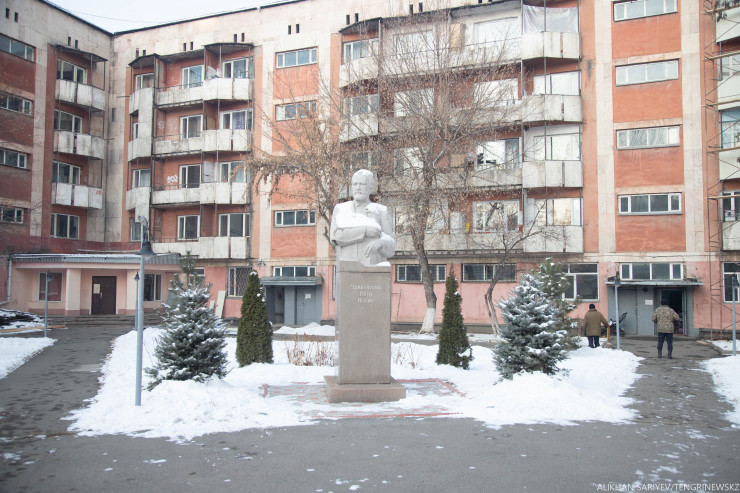
Pyotr Tchaikovsky is called one of the world’s greatest composers, a bright representative of romanticism, an outstanding lyricist and playwright-psychologist in music. He left behind 10 operas, three ballets, seven symphonies, 104 romances and other works.
And now we need to cross Abay Avenue. Here, in the courtyards between Manas and Baizakov, there is the Almaty College of Decorative and Applied Arts named after Oral Tansykbayev. In 2012, a bust of Oral Tansykbayev was installed on its territory, the author is also Erkin Makulbayev. Oral Tansykbayev is a Soviet, Kazakh and Uzbek artist of Kazakh origin, who is also one of the founders of Uzbek painting. He spent most of his life in Uzbekistan, left behind hundreds of works, and exhibited in Moscow and the United States. After his death, a museum was opened in the house where he lived in Tashkent.
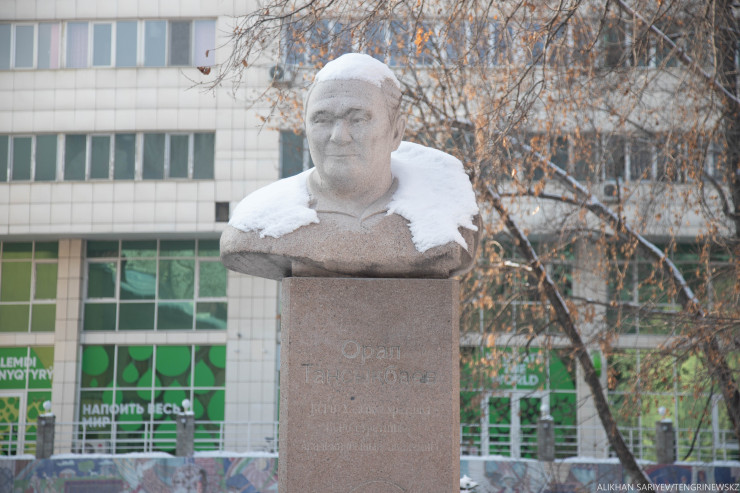
We go further along the Abay in the direction of Baizakov. Here, near the former building of the Kazakh State Law Academy, the “Themis Square”was opened in 2001. The monument was opened in honor of the 10th anniversary of the country’s independence. The authors of the project are sculptor Murat Mansurov, architect Oleg Balykbayev and designer V. Menchenko.
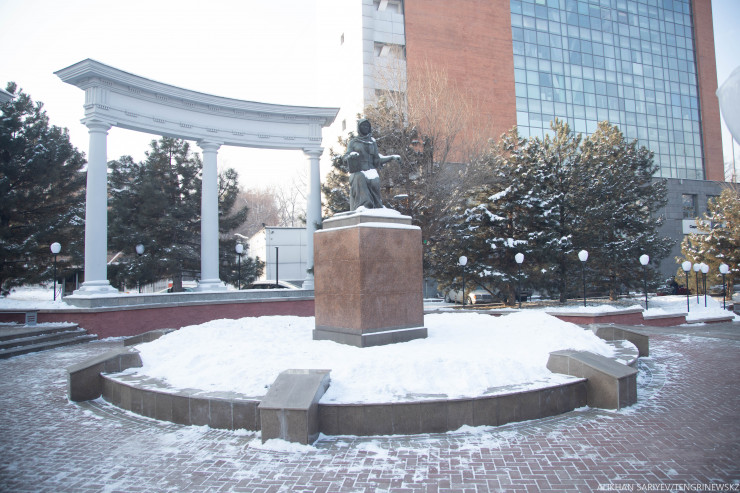
On the square you can relax a little and if you want to think about the justice of life and the vicissitudes of justice.
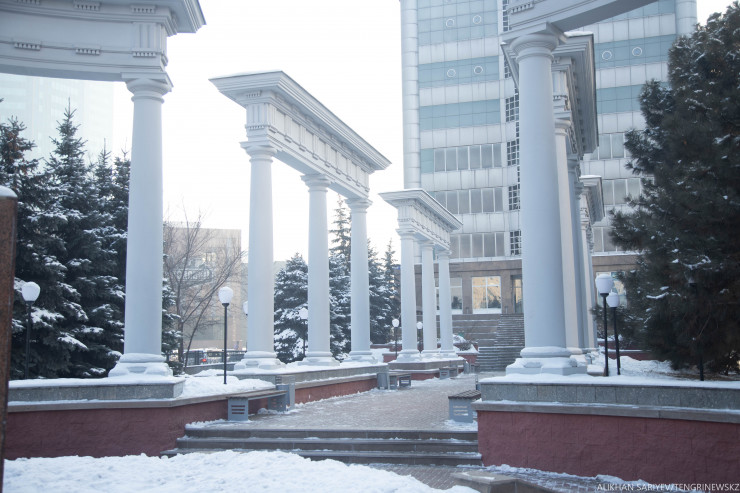
Next door are the circus and the park “World of Fantasy Almaty”, which you can visit if you are with children. Especially in the summer, when they launch attractions. And a little higher at the intersection of Musrepov and Satpayev Streets is the Abylkhan Kasteev State Museum of Art. The monument in honor of the founder of the Kazakh fine art was established in 2004 in honor of the centenary of the artist. The sculptor is Nurlan Dalbayev. The figure of a sitting artist with a palette and brush in his hands is cast in bronze.
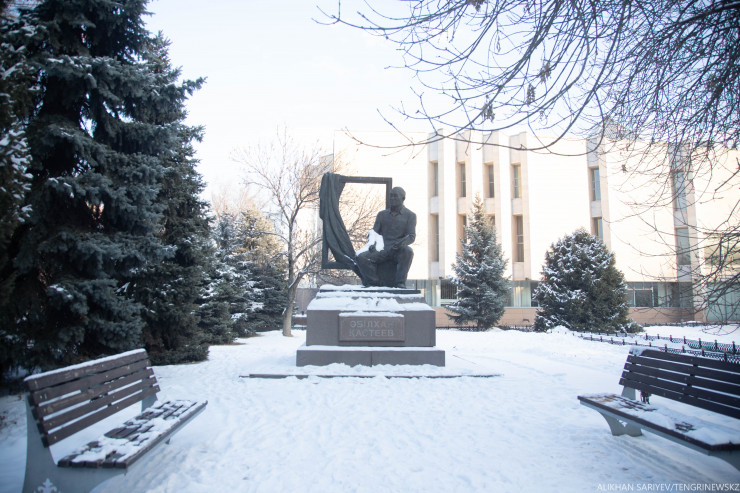
Among the most famous works of Kasteev: “Collective farm dairy farm”, “Milking mares”, “Cotton harvesting”, “Collective farm toy”, “Forced removal of the bride”, “Bought bride”, “Golden Grain”, “Aksai quarry”, “Medeo High-mountain skating rink”, “Turksib”, “Talas Valley” and “Kapchagai Steppe”. He also created a portrait of Amangeldy Imanov, Kenesary Kasymov, Abai, Shokan Ualihanov and Zhambyl Zhabayev.
After enjoying a visit to the museum, we go further. At the intersection of Satpayev and Baitursynov Streets in the square near Satbayev University in 1999, a monument was erected to the geologist, the first president of the Academy of Sciences of Kazakhstan Kanysh Satpayev. The monument was erected in honor of the 100th anniversary. The sculptor is Tulegen Dosmagambetov.
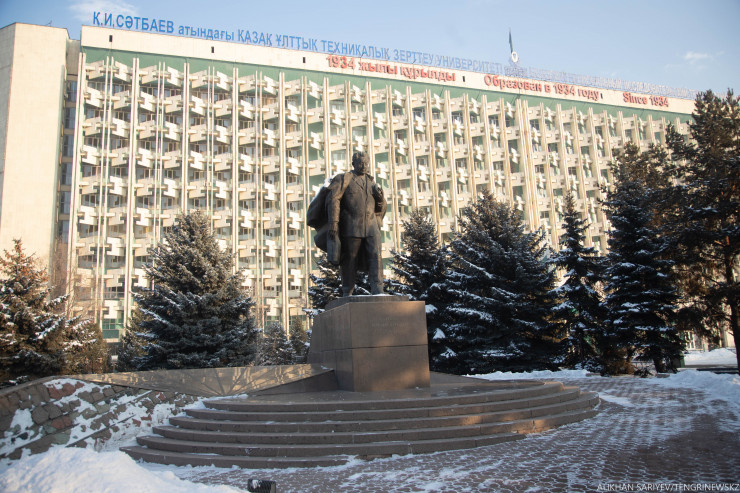
Kanysh Satpayev in the 1930s discovered the Ulutau-Dzhezkazgan international field, which at the time of discovery was considered the largest in the world in terms of projected reserves. Under his leadership, in the 40s, the Dzhezdinsky deposit of manganese ores was discovered, which allowed the USSR, despite the loss of territories in Ukraine and Georgia, to continue producing armored steel. In 1935, Kanysh Satpayev discovered a stone with an inscription, which was left by Tamerlane in 1391 during a campaign in the Kazakh steppe. He is also the author of the first school textbook on algebra in the Kazakh language, educator of a number of scientific personnel, such personalities as Shafik Chokin, Alkey Margulan, Yevney Buketov. He owns more than 640 scientific papers, he is also a major organizer of science, which made the Academy of Sciences of the Kazakh SSR one of the largest republican academies in the USSR, turning the Institute of Geological Sciences into one of the largest organizations of geological profile in the country.
And at a distance of one bus stop from Satbayev University on Baizakov Street, above Bukhar Zhyrau Boulevard, in the square near the Kulyash Baiseitova Music School, there is a monument to the opera singer Kulyash Baiseitova. It was installed in 2011 on the eve of the singer’s 100th birthday. The sculptor is Tleuberdy Binasi.
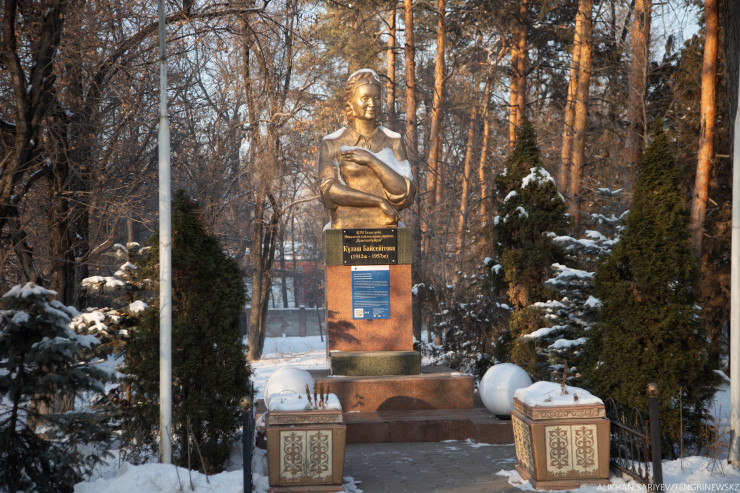
Kulyash Baiseitova had an incredible talent, at the age of 24 she received the title of People’s Artist of the USSR, her name was famous throughout the country and abroad. She was able to create real, sincere images of Kazakh women, and in addition, she was one of the first to perform on the Kazakh stage parts from classical operas by Tchaikovsky, Puccini, Rubinstein. Kulyash Baiseitova’s musical talent was clearly manifested in the creation of the image of Ayman in the musical comedy “Ayman-Sholpan”, the image of Shuga (musical drama” Shuga”), the role of Zhibek in”Kyz-Zhibek”. Her appearance in the sky of opera was called the flash of a bright star.
Climbing higher on Timiryazev Street, you can take a walk in the park near the Al-Farabi Kazakh National University. In front of the main administrative building of the university is a monument to Abu Nasr al-Farabi. The sculptor is Esken Sergebaev. Initially, the sculptor himself planned that the monument to the philosopher would be installed at the intersection of Al-Farabi and Dostyk Avenues, not far from the monument to Abai. However, this idea was not implemented. As a result, the installation of the monument was funded by private organizations supporting the university.
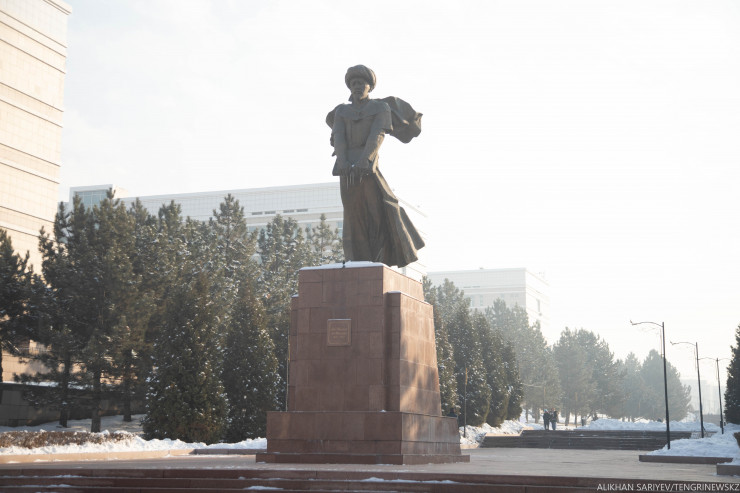
Al-Farabi is one of the greatest representatives of medieval Eastern philosophy, the author of commentaries on the works of Aristotle (hence his honorary nickname of the Second Teacher) and Plato. He is credited with the creation of the Otrar library. The works of the philosopher al-Farabi influenced Ibn Sina, Ibn Rushd, as well as the philosophy and science of medieval Western Europe. He was born in what is now Turkestan province. He spent the last part of his life in Damascus, Syria, moving there in 941.
A monument to the outstanding scientist, organizer of science and education, Academician Umirbek Dzholdasbekov was opened here on the territory of the university in 2011. The opening was timed to coincide with the 80th anniversary of the scientist. He is the founder of the school of robot mechanics, theory of mechanisms and machines in Kazakhstan. For many years he led the first university in the country. The sculptor is Kadyrkhan Kakimov.
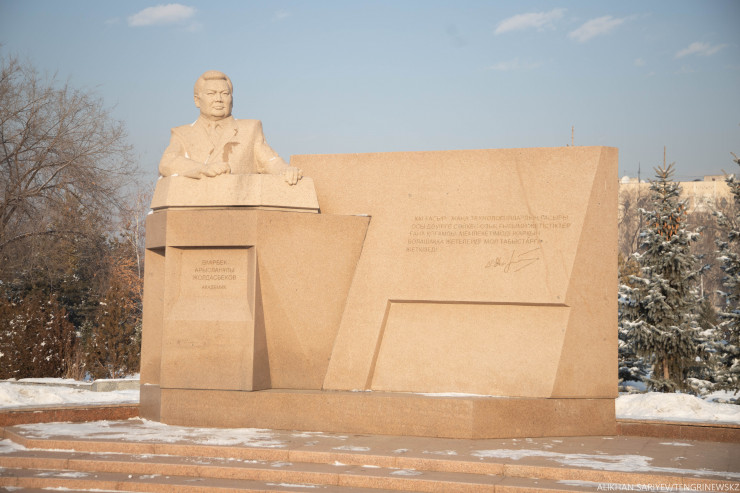
We go further, of course, along Al-Farabi Avenue. Kazakhfilm Studio is located at the intersection with Gagarin Avenue. Here you can walk along the Walk of Fame, which has stars with the names of Kazakhstani film figures. There is also a marble bust of the great Kazakh director Shaken Aimanov. Another monument to Shaken Aymanov was installed in 2019 at the hotel “Almaty”, where in 1968 the shooting of the musical film”Angel in a Skullcap” took place.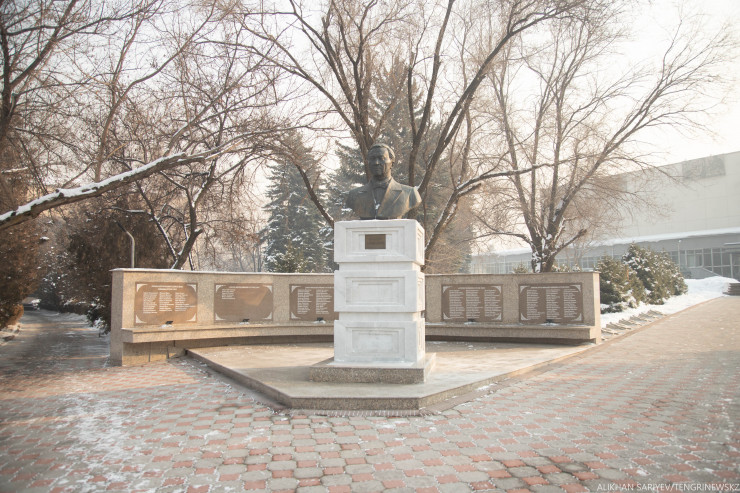
In this part of the route, we will most likely need a car, because the remaining monuments are located quite far from each other. And it will be necessary to choose the further direction of the path. It will be easier to go down Gagarin Avenue, using public transport.
The first stop is a place that will remind us of the unusual history of friendship. At the intersection with Baykadamov Street there is a monument to Bakhytzhan Baykadamov, a Kazakh composer. He is the author of the musical drama “Mayra” (1952), symphonic poems “Bright Youth” (1952), “Collective Farm Holiday” (1953), suites for choir: “On Dzhailau”, “For Peace” and others; vocal compositions, major poems for choir – “Dream of a Girl”, “Aitys”, “Fruit of Labor”.
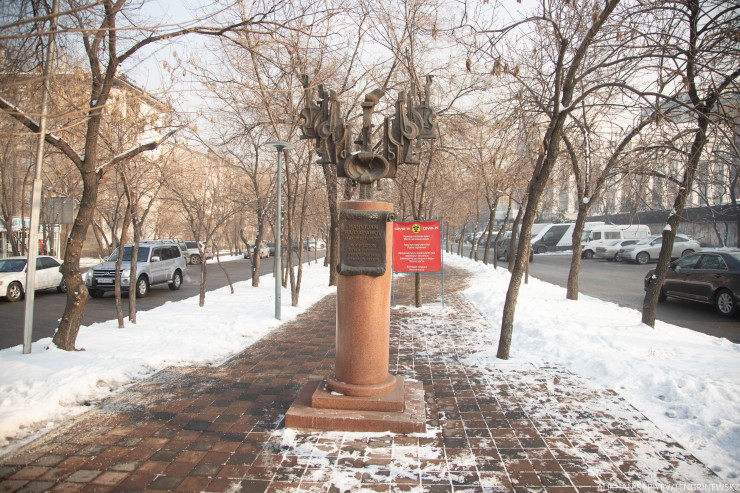
He made a great contribution to the development of the choral song genre in Kazakhstan.
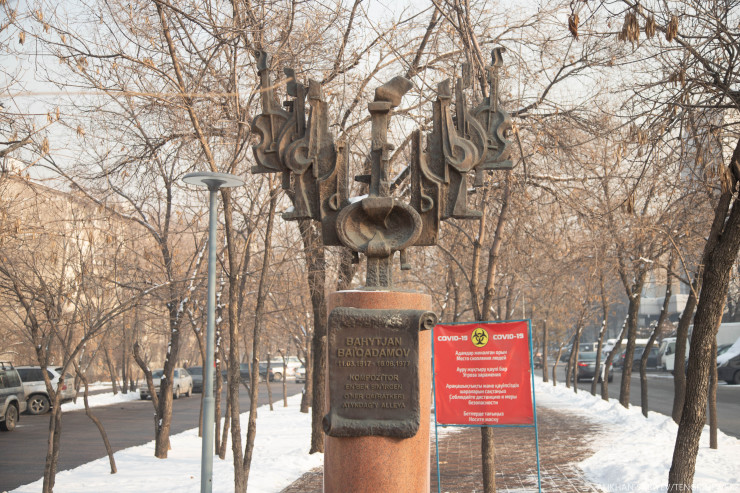
A nearby street is named after the Chinese composer Xi Xinghai. He was born in 1905 in the Chinese city of Macao. He studied in Paris, and in 1935 returned to China to take part in the anti-Japanese movement. In 1939, he joined the Communist Party of China. The following year he was sent to the Soviet Union for the filming of the movie musical. But the war prevented the plans, and so Xi Xinghai in 1943, after unsuccessful attempts to return to China, found himself in Alma-Ata, where enterprises, including Mosfilm, were evacuated.
Here he made friends with Bakhytzhan Baykadamov, who shared the last piece of bread with him. During the two and a half years of his life in Alma-Ata, he composed the first symphony “National Liberation”, the second symphony “Holy War”, symphonic works – “Chinese Rhapsody”,” Amangeldy ” and others. In addition, he collected and reworked many Kazakh folk songs, becoming a messenger of Chinese-Kazakh friendship. The film “Composer”was made about the friendship of Si Sinhai and Bakhytzhan Baykadamov.
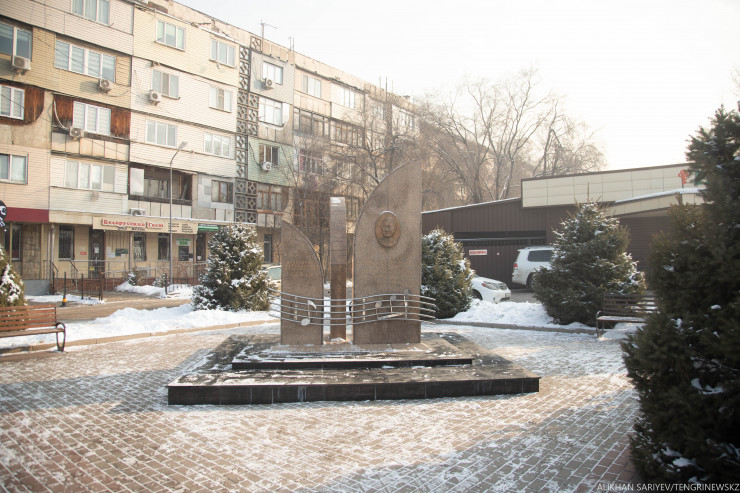
A monument to the composer was erected in 1999 on Xi Xinghai Street, which received this name in 1998. The obelisk is engraved with a brief biography of Xi Xinghai in Chinese, Kazakh and Russian, as well as the first musical line of the symphonic poem “Amangeldy”. This place is popular for pilgrimage among tourists from China.
We go down to the intersection of Zhandosov and Gagarin streets. A monument to the revolutionary Uraz Zhandosov was erected here in 1969. The sculptor is Nikolai Zhuravlev. Uraz Zhandosov is considered one of the founders of the national construction of Soviet Kazakhstan, who had a significant impact on the content and dynamics of creative processes in the field of public education and national Kazakh culture. He was an active participant in the revolutionary events in the Semirechensk region. Later, he organized the first universities in Kazakhstan, provided assistance to the starving population, and was engaged in the development of agriculture.
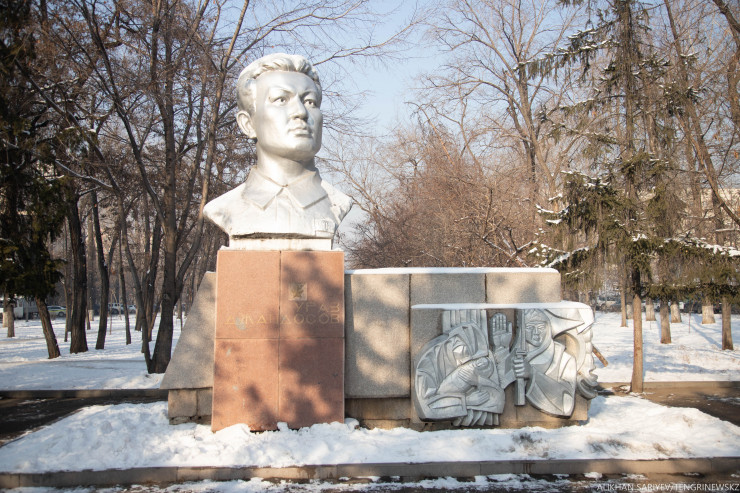
In this part of the route, we recommend that you still take a walk. A little lower, not reaching Abay Avenue, on the bench on the left there is a monument to the first cosmonaut Yuri Gagarin. The composition is made in a playful way and is set in 2018. The authors of the project are students of the Kazakh Academy of Arts named after Zhurgenov Azamat Kabyl and Akylbek Shaken.
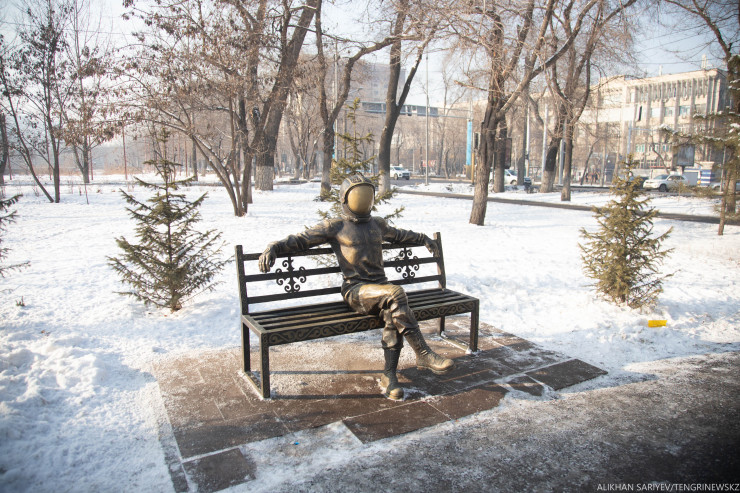
We go down to Shevchenko. Mahatma Gandhi Park is located here. The monument to the Indian politician is installed in the eastern part closer to Zharokova Street. It was installed in 2003. Gandhi’s granddaughter Sumitra Kulkarni was present at the opening ceremony. In appearance, it is a copy of the Moscow monument to Mahatma Gandhi, opened on July 8, 1988 on Indira Gandhi Square.
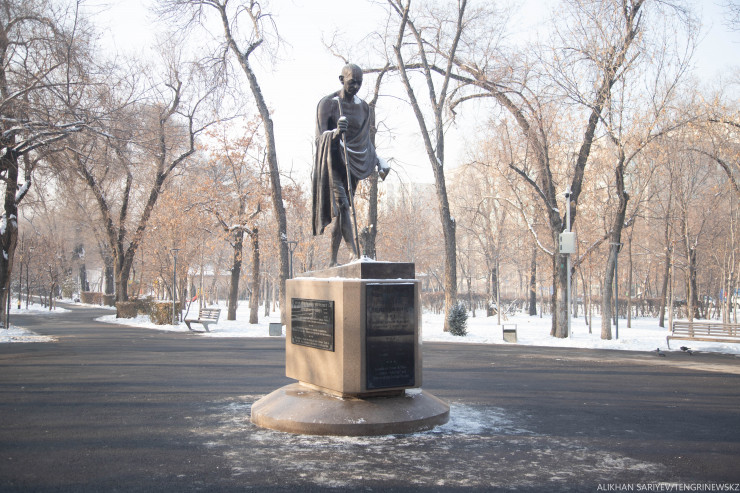
The last and largest point of our route remains. This is the square behind the Sary-Arka cinema at the intersection of Abay and Altynsarin Avenues, which is the last refuge for monuments to Vladimir Lenin, Mikhail Frunze, Maxim Gorky, Mikhail Kalinin, fighters of the October Revolution, Pavel Vinogradov and Dmitry Furmanov. They all once stood on the streets of Almaty.
The monument to Soviet leader Vladimir Lenin stands in the center. One of Lenin’s hands is outstretched, the other is holding the cloak. His face is focused, his brows drawn together. Furmanov and Frunze sat modestly on Lenin’s right hand. There is also a monument to the fighters of the October Revolution. On Lenin’s left hand is the Bolshevik revolutionary Pavel Vinogradov. Writer Maxim Gorky, who spent many years standing in the Central Park of Culture and Recreation, is now also here. These monuments look especially interesting in the evening.
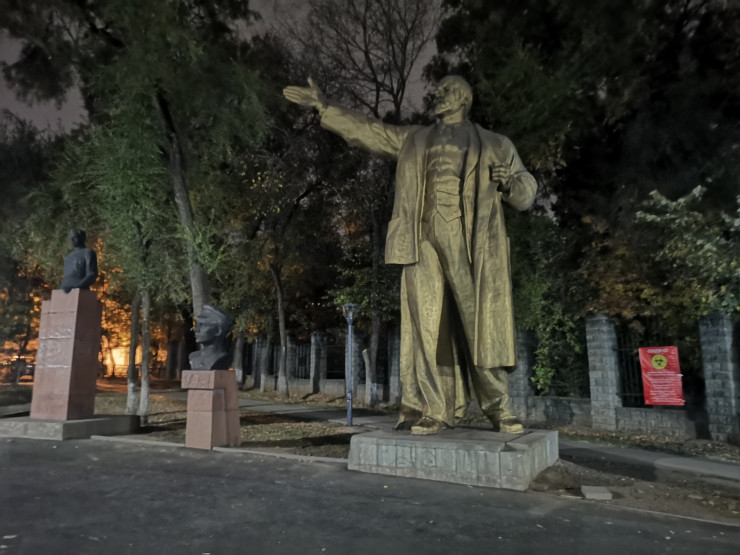
According to the Mayor’s Office of Almaty, the monument to Lenin was installed in 1957 in the square near the Government House (now Astana Square). In 2007, it was moved behind the Sary-Arka cinema. Sculptor-Evgeny Vuchetich, architect-Ivan Belotserkovsky.
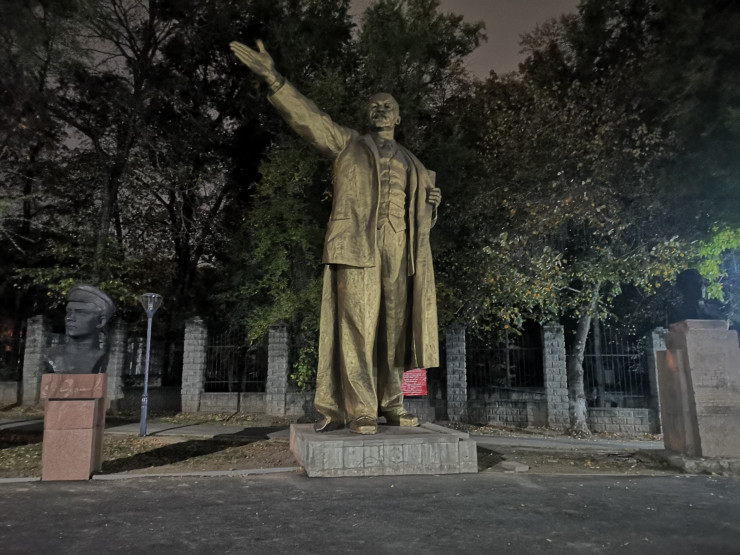
The monument to the fighters for the establishment of Soviet power in Semirechye was erected in 1967 at the intersection of Rayymbek Batyr Avenue and Pushkin Street. The pedestal for the Sary-Arka cinema was moved in 2012.
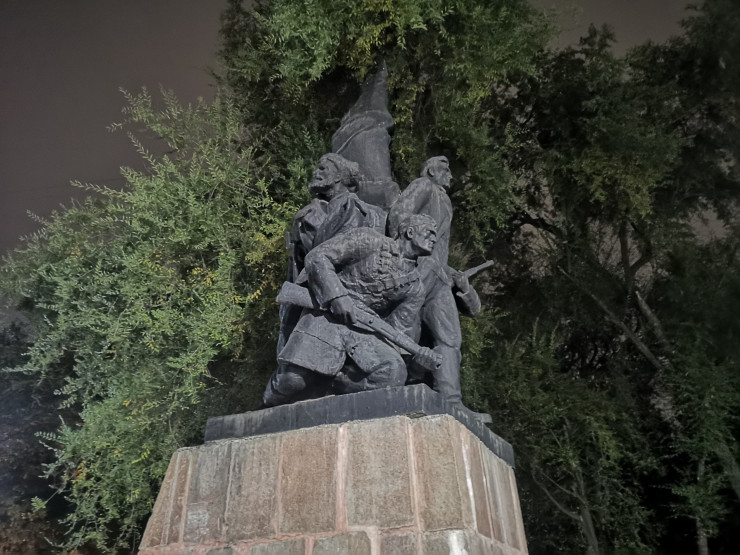
The monument to Mikhail Frunze was erected in 1967 in the square on Kabanbay Batyr Street (formerly Kalinin Street), corner of Nauryzbay Batyr Street (formerly Dzerzhinskiy Street). In February 2007, it was moved to the square behind the Sary-Arka cinema.
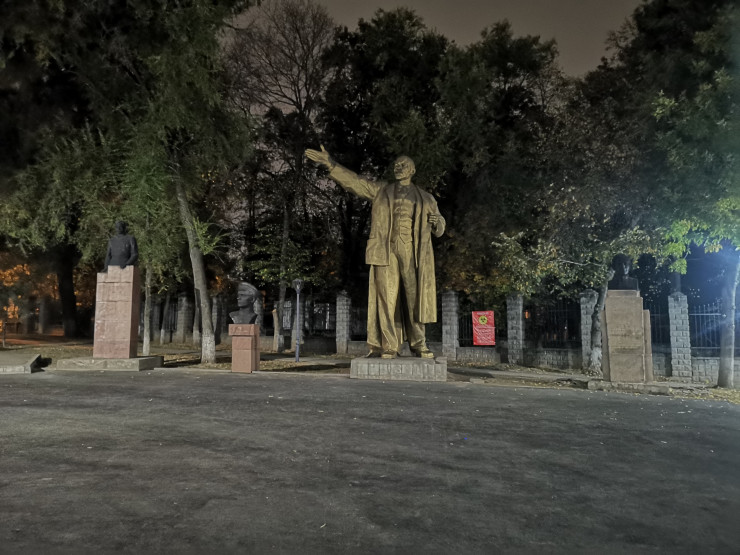
Since 1956, the bust of Pavel Vinogradov has stood at the intersection of Vinogradov Street (now Karasay Batyr) and Dzerzhinskiy Street (now Nauryzbay Batyr). In 2012, it was moved behind the Sary-Arka cinema. The monument to Kalinin was erected in 1972 in front of the Alma-Ata-2 railway station. In 1992, it was moved to the Park of culture and recreation of the Auezovsky district. In 2007, it was moved behind the Sary-Arka cinema.
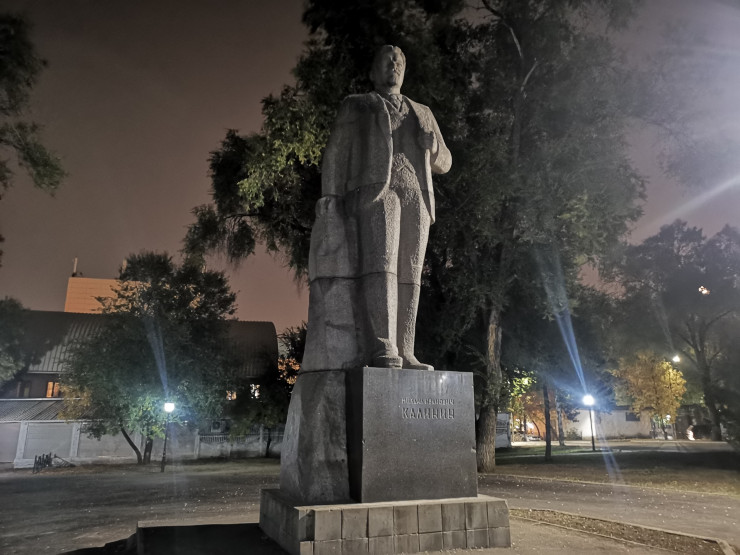
The monument to Maxim Gorky was erected in 1940 on the central alley in the Central Park of Culture and Recreation named after Gorky. In 2015, it was moved behind the Sary-Arka cinema. The bust of Furmanov was installed in 1967 at the intersection of Furmanov Street (now Nazarbayev Avenue) and Kurmangazy Street. In 2018, it was moved to the Sary-Arka Square. These monuments are no longer protected by the state, but they are taken care of by local residents. In the future, it is planned to create a unique park of “Soviet Sculpture” in Almaty.
We have already mentioned that these monuments can be visited on foot, by public transport and by car. But you don’t have to stick to the established routes. For example, a resident of Almaty, Sunkar Karabalin, due to the fact that a parade dedicated to the Great Victory was not organized in Almaty on May 9, decided to go around the memorable places on his own on a bicycle.
“Together with my son, whom I took to the parade as a child, this time we drove through memorable places. The discovery for me was that we have an alley of memory on the territory of our Medical Institute (KazNMU named after Asfendiyarov-approx. author), dedicated to the students and staff of the university who went to the front. Then we visited other memorable places. We visited Abylai Khan, where there is a bust of pilot Lugansky, monuments to Aliya Moldagulova and Manshuk Mametova and a monument to Baurzhan Momyshuly. And the park named after 28 Panfilov Guards was closed at that time. I managed to take a picture from afar.
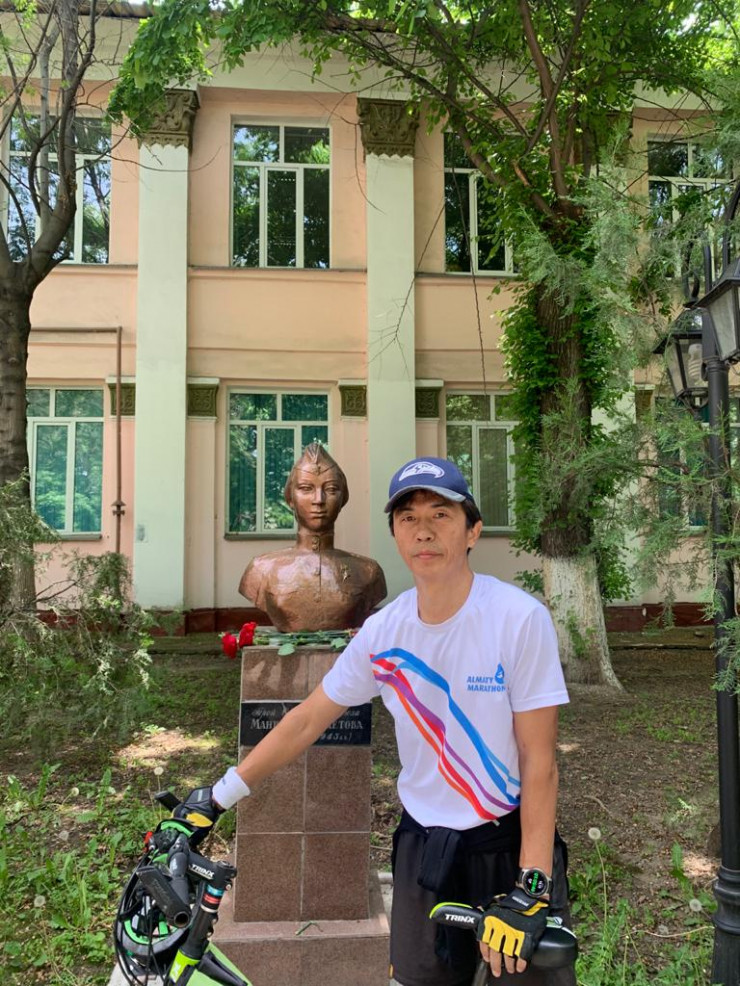
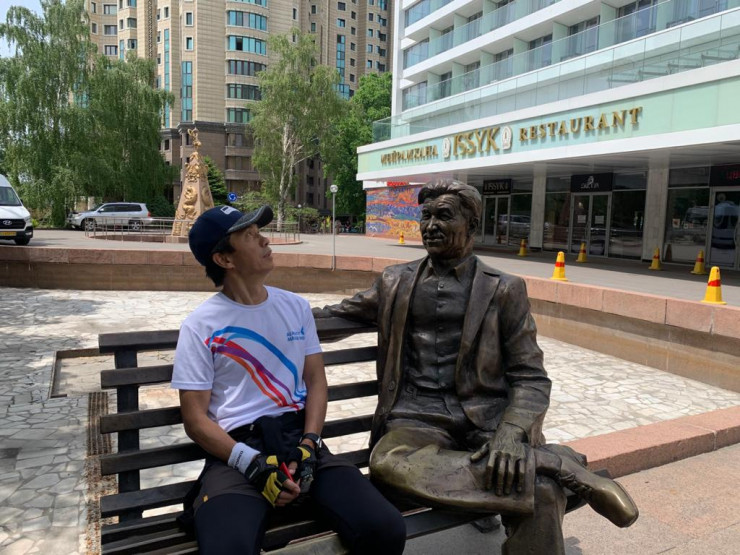
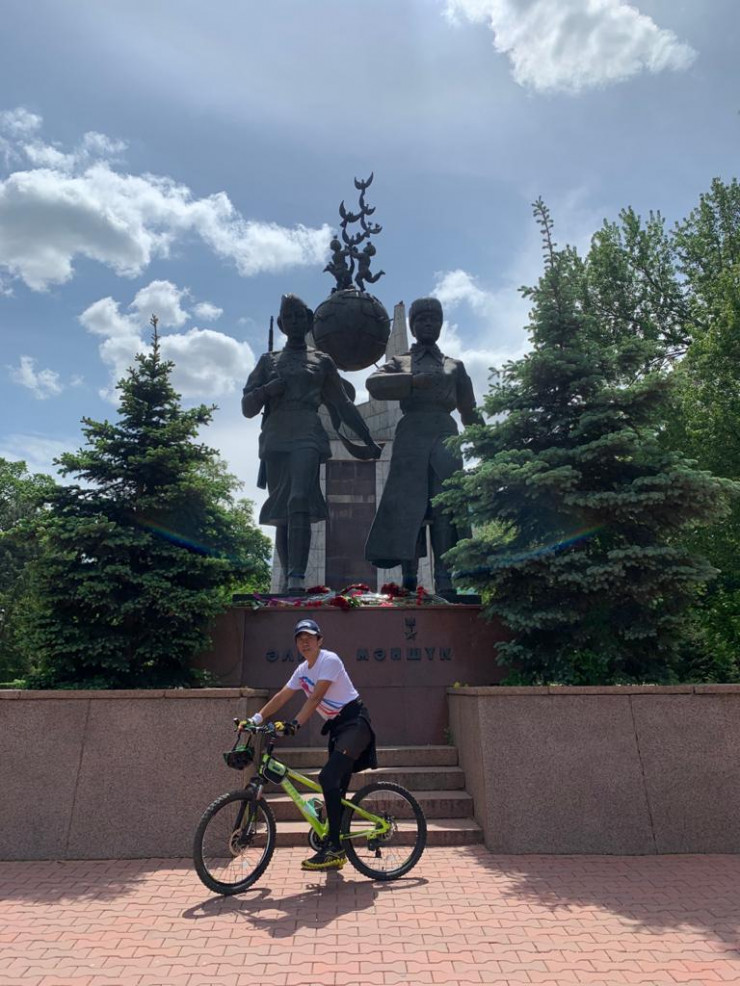
Unfortunately, there are no monuments to Rakhimzhan Koshkarbayev, Kasym Kaisenov, or Talgat Begeldinov in our city. Perhaps this issue should be raised. But I managed to take a picture with the sculpture of Shaken Aimanov, installed at the hotel, ” the man shares.
There are also memorable places in the Almaty mountains.
“On Mount Kumbel there is a memorial plaque dedicated to the feat of Rakhimzhan Koshkarbayev and Grigory Bulatov, who installed the flag of the USSR on the Reichstag building on April 30, 1945. As an option, next year you can visit this place together with Dauren Koshkarbayev, the grandson of the famous warrior, ” he said.
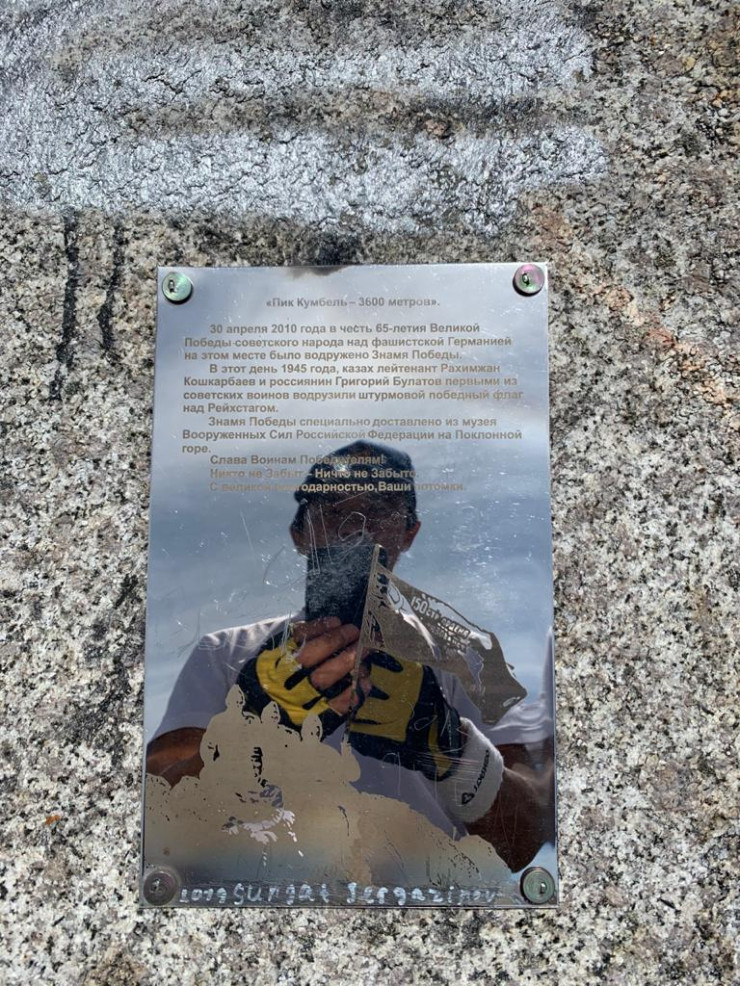
Also in Gorelnik there is a sign dedicated to the school of mountain shooters who once worked in these places, who were trained for war.
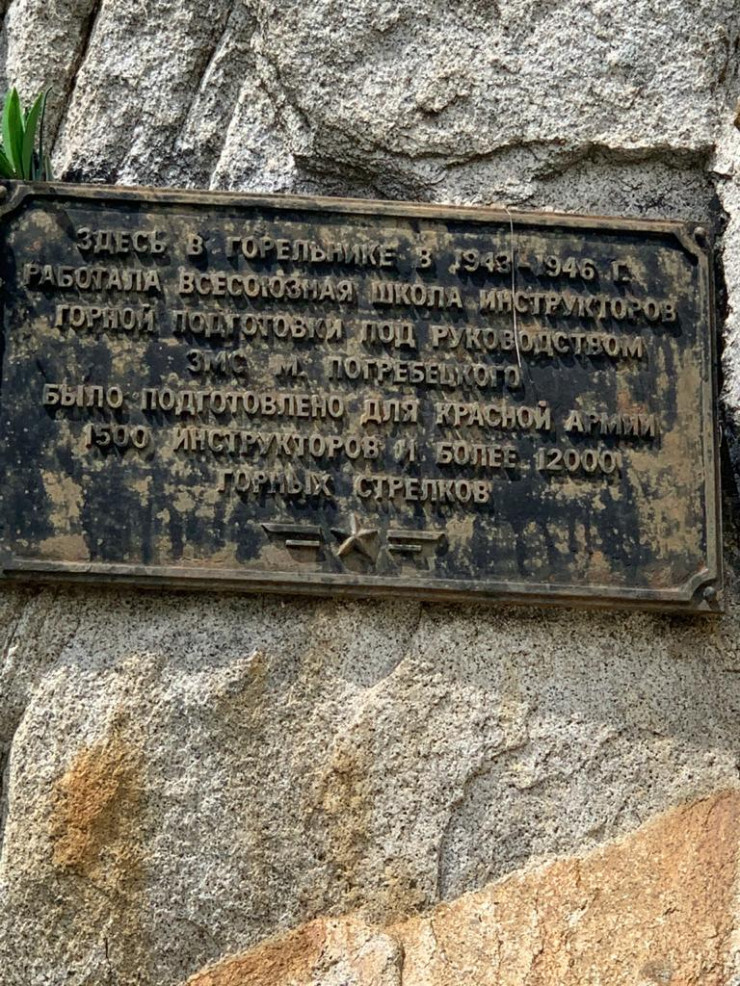
There is also a memorial plaque on the Big Almaty Peak. “On February 2, 1971, one hundred athletes of the company “Kyzyl Tu” made an ascent to this peak in honor of the 53rd anniversary of the Soviet Army,” reads the inscription on the sign.
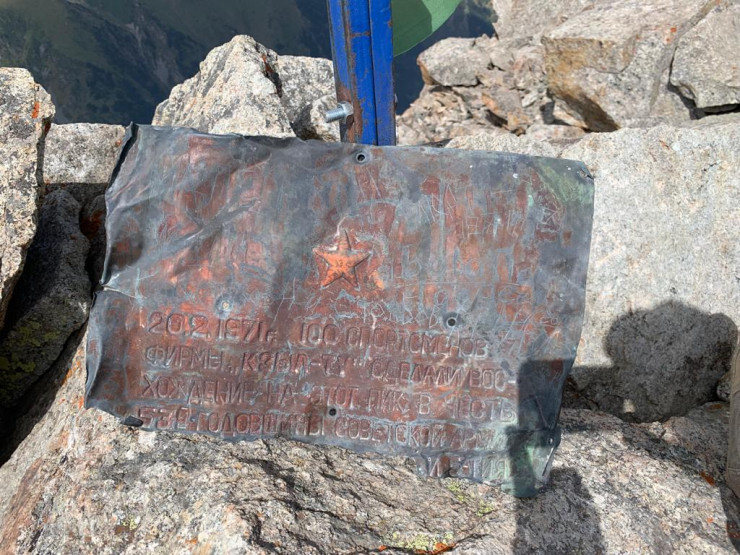
“Always when looking at the mountains from the city, I was attracted by the peak that crowned the Almarasan Gorge. From the city, it seems so out of reach. But thanks to my vacation, my son, who asked me to take him with friends, I ended up here with them, ” the man shared.
Sunkar Karabalin was lucky to see a large number of monuments during the summer race Race Nation. Usually it was held in extreme conditions in nature, but this year, due to the quarantine, it was held in the city, each participant was given an individual route.
“I chose 17 kilometers. During the race, he performed physical exercises: pulling up, lifting the wheel, archery, and so on. I started at the Palace of Schoolchildren and moved towards Lake Sairan. I didn’t build the route on purpose, but on the way I met a large number of monuments. I enjoyed both the race and getting acquainted with the memorable places of our city,” Sunkar Karabalin said.
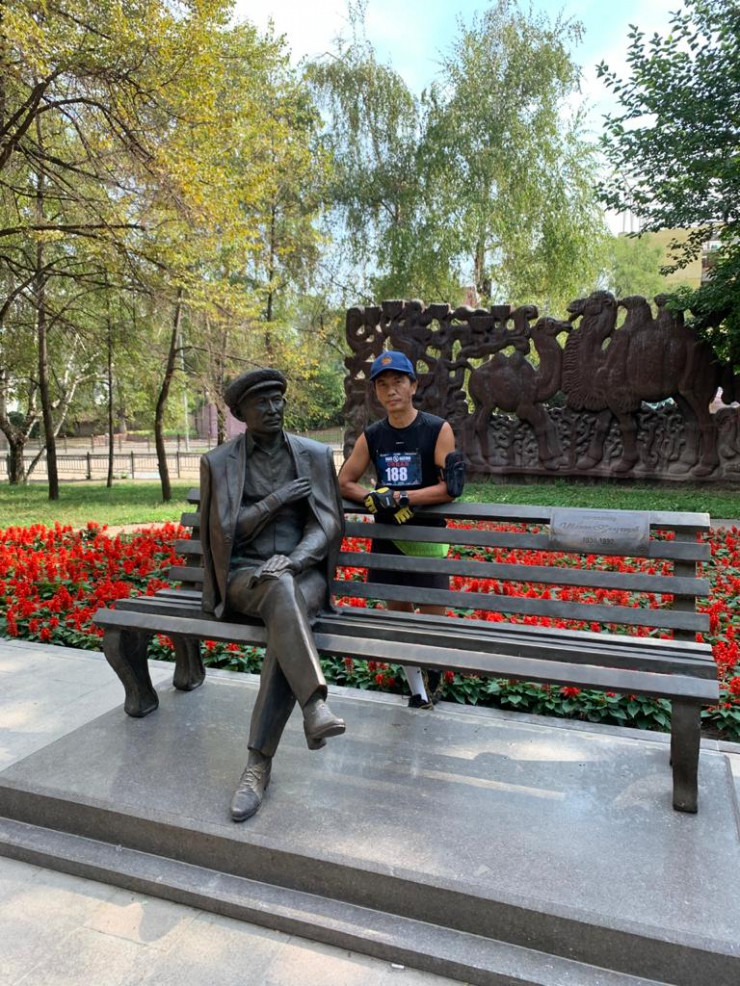
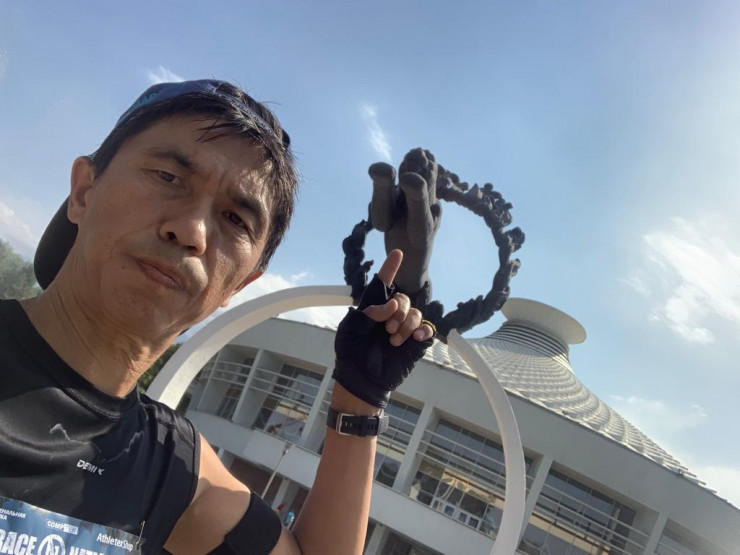
He also has monuments that he visits every year, such as the memorial to the victims of repression. It is located near Almaty, at the entrance to the village Burundi in a place called Kandisa.
“We go there almost every year. According to one version, one of our grandfathers – Uzakbay Kulumbetov, who was the chairman of kaztsik from 1935 to 1937, headed the government of Kazakhstan, is buried there,” he says.
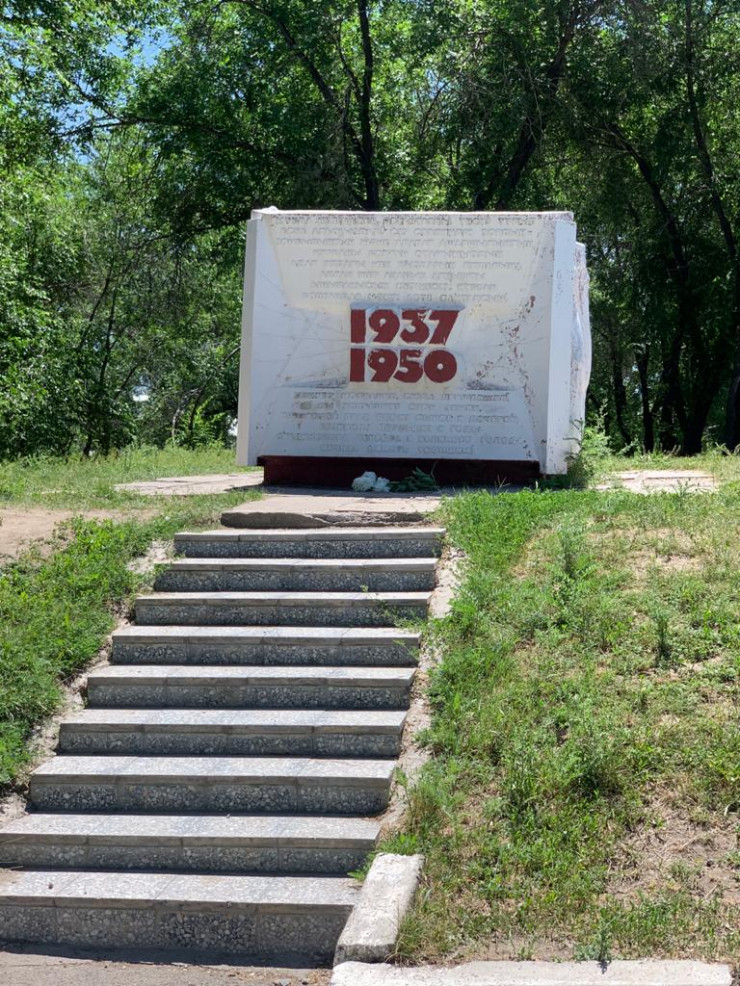
Information taken from the site Tengritravel.kz
























































